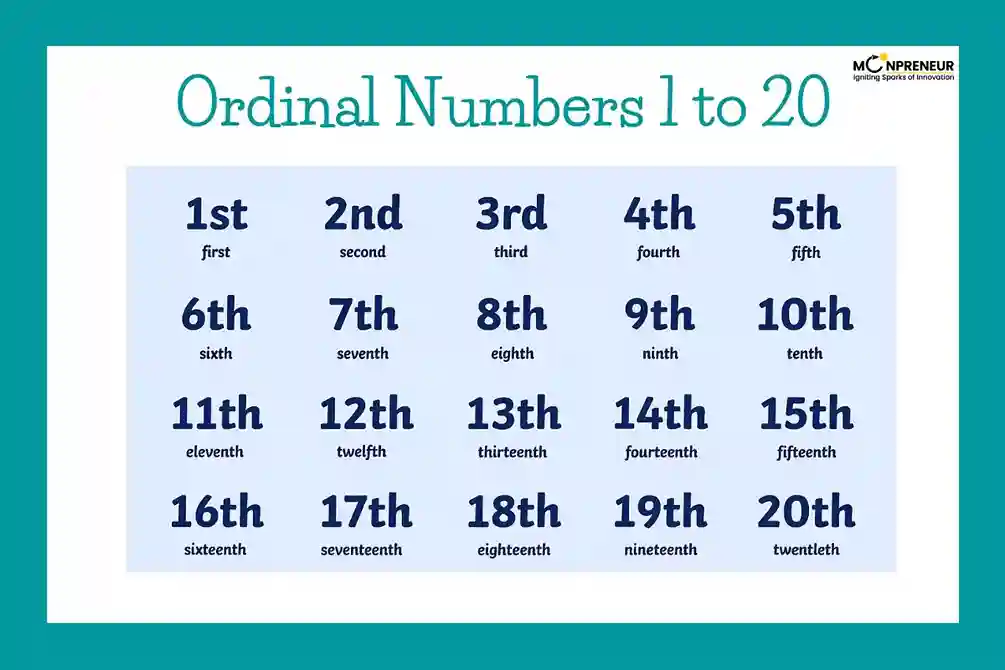Ordinal Numbers 1 to 20: Step-by-Step Learning
Introduction
Children often learn to count very quickly using cardinal numbers like 1, 2, 3, and so on. But what about describing the position or order of objects? That’s where ordinal numbers come in. For example, when we say “I came 2nd in the race” or “Today is the 15th of February”, we are using ordinal numbers.
In this guide, we’ll explore ordinal numbers 1 to 20, their meaning, differences from other types of numbers, examples, and practice problems.
What Are Ordinal Numbers?

Ordinal numbers describe the position or order of objects or people in a sequence.
- Example: In a race, the runner who finishes first is 1st, the next is 2nd, then 3rd, and so on.
Unlike cardinal numbers (which answer “how many”), ordinal numbers answer “what position”. Example:
- 5 apples (cardinal number)
- The 3rd apple in the row (ordinal number)
Difference Between Cardinal, Nominal, and Ordinal Numbers
To understand ordinal numbers better, let’s compare them with other number types:
-
Cardinal Numbers – These are counting numbers that show how many.
Example: 1, 2, 3, 4, 5… -
Nominal Numbers – These are labels or identifiers given to objects.
Example: Pin codes, jersey numbers, bus numbers. -
Ordinal Numbers – These show the position or order.
Example: 1st place in a race, 2nd row in class, 15th birthday.
Examples of Ordinal Numbers in Daily Life
Here are some easy-to-understand examples:
- My birthday is on the 15th of February.
- The library is on the 3rd floor of the building.
- I study in the 6th grade.
- The 1st month of the year is January.
- In the word NEST, S is the 3rd letter.
Ordinal Numbers 1 to 20 List

| Ordinal | Word |
|---|---|
| \(\displaystyle 1^{st}\) | First |
| \(\displaystyle 2^{nd}\) | Second |
| \(\displaystyle 3^{rd}\) | Third |
| \(\displaystyle 4^{th}\) | Fourth |
| \(\displaystyle 5^{th}\) | Fifth |
| \(\displaystyle 6^{th}\) | Sixth |
| \(\displaystyle 7^{th}\) | Seventh |
| \(\displaystyle 8^{th}\) | Eighth |
| \(\displaystyle 9^{th}\) | Ninth |
| \(\displaystyle 10^{th}\) | Tenth |
| \(\displaystyle 11^{th}\) | Eleventh |
| \(\displaystyle 12^{th}\) | Twelfth |
| \(\displaystyle 13^{th}\) | Thirteenth |
| \(\displaystyle 14^{th}\) | Fourteenth |
| \(\displaystyle 15^{th}\) | Fifteenth |
| \(\displaystyle 16^{th}\) | Sixteenth |
| \(\displaystyle 17^{th}\) | Seventeenth |
| \(\displaystyle 18^{th}\) | Eighteenth |
| \(\displaystyle 19^{th}\) | Nineteenth |
| \(\displaystyle 20^{th}\) | Twentieth |
Solved Examples
Q1. Fill in the blanks with the correct ordinal numbers.
- S is the ___ letter in the word NEST.
- C is the ___ letter in the word CLASS.
Answer:
- S is the 3rd letter in the word NEST.
- C is the 1st letter in the word CLASS.
Q2. Sam, John, Mary, and Louis are standing in a row in this order. Who is in the second position?
Answer: John is in the 2nd position.
Practice Problems
- Write all ordinal numbers from 1 to 20 in order.
- In the word BEAUTIFUL, find the 1st and the last letter.
- Answer: 1st → B, Last → L.
- Answer: 1st → B, Last → L.
- Who is the 4th person in your class attendance register?
- Write the ordinal number for your birth date.
Summary
Ordinal numbers are essential for describing the order, sequence, and arrangement of objects or people. They help us organize information in a logical way, making them useful in mathematics, science, literature, and daily conversations.
From identifying dates to arranging competitions, ordinal numbers 1 to 20 form the basic building blocks for kids to understand order and ranking. With the help of examples, solved problems, and practice exercises, learning ordinal numbers becomes simple and engaging.
Want to spark your child’s interest in math and boost their skills? Moonpreneur’s online math curriculum stands out because it engages kids with hands-on lessons, helps them apply math in real-life situations, and makes learning math exciting!
You can opt for our Advanced Math or Vedic Math+Mental Math courses. Our Math Quiz for grades 3rd, 4th, 5th, and 6th helps in further exciting and engaging in mathematics with hands-on lessons.
Related Blogs:
Step Deviation Method in Statistics – Definition, Formula, and Solved Example
What is the Frequency Formula? Definition, Examples, and Related Equations
What Is the SAT Essay? Everything You Need to Know
An overview of the SAT Math Test Sections
SAT Superscore: What It Is and Why It Matters?
Mean vs. Median vs. Mode: What is the Difference?
Mathway Reviewed: Pros, Cons, and Everything You Need to Know
















